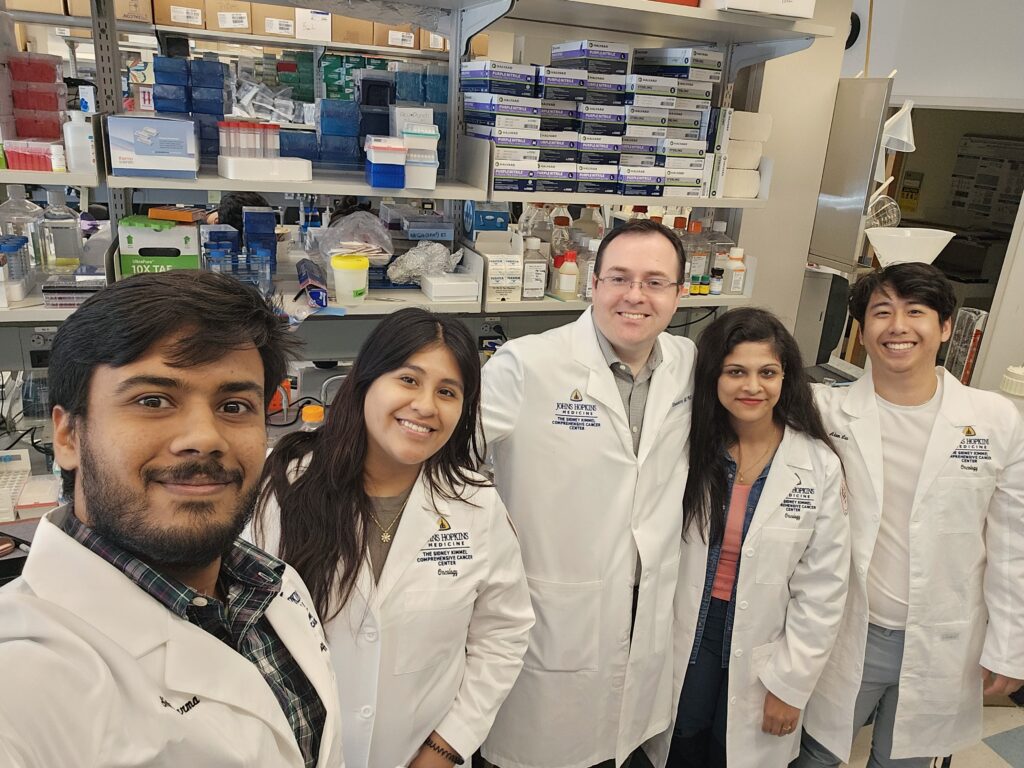
June 16, 2025 | By Jasmyne Ferber, IT@JH

INVESTIGATOR
- Name: Eugene Shenderov, M.D., D.Phil, FACP
- Affiliation: Oncology, Johns Hopkins School of Medicine
- Services Used: DISCOVERY (HPC), SAFER/SAFE (Desktop), SAFESTOR

USE CASE
Eugene Shenderov, an associate professor of oncology and cancer research immunology at the School of Medicine and the Director of the Spatial Cancer Research Immunobiology & Therapeutics Laboratory (SCRIPT Lab), has been with Johns Hopkins for nearly 20 years. From conducting single cell and bulk RNA sequencing analyses to his work in spatial biology using advanced techniques to quantify and visualize gene and protein expression, Shenderov is highly aware of the increasing needs for big data storage, integration and computation, and how IT@JH services can support them.
In fact, his ties with IT@JH began when he met Greg Smith – then a senior IT manager – in the Johns Hopkins Hospital’s Oncology Department, now a Director with IT@JH.
“We continued to support Eugene after moving to IT@JH,” Smith said. “He was one of the first adopters of our Research IT infrastructure.”
So, when Shenderov’s research team needed help storing massive amounts of sensitive data to support their critical work in developing an AI algorithm to speed up early diagnosis of a rare type of leukemia, contacting the IT@JH team was second nature.
“Research IT is central to how you store data. It’s been part of the evolution of generating data, acquiring equipment, and installing it to be able to collect the data,” Shenderov said. “As soon as you start realizing that you’re going to be doing things that are data-intensive, you’re going to need IT.”
To determine the most effective way to configure their research environment to allow for the analysis, transfer and storage of sensitive data, Shenderov’s team reached out to Tyler Creamer, an RIT facilitator, to address their needs.
In his initial discussions with Shenderov, Creamer noticed there were a lot of different services that needed to be connected in a manner that was logistically difficult and complex.
“Eugene laid out the entire project from start to finish of the data going in and the data that he wants coming out,” Creamer said. “Then we were able to sit down with our engineers and architect and really figure out how to get from A to Z.”
The solution? A curated mix of DISCOVERY (HPC) and SAFER/SAFE Desktop – which were specifically built to meet the complex needs of diverse research at Johns Hopkins. Shenderov noted that compared to 20 years ago, the number of resources available to researchers is vastly higher now, raising the complexity and making it that much harder for researchers to find the right platforms to use.
“Part of it is because there is greater hacking, so we’ve made it much harder to download things because we have to have more secure firewalls,” he said. “There’s no way you’re going to navigate this even if you have an IT background. You’re going to need an IT person who’s been here for a while to navigate you until you can get to where you need to go.”
Shenderov also noted that working with IT@JH has been crucial for his team, particularly thanks to shared resources, which helped his team navigate the complex security requirements of governing bodies without the worry of commercialization or data misuse.
“The establishment of the research IT environment created a pipeline for having the room to do it from a monetary perspective,” Shenderov said, referring to the institutional investment and subsidy of the research IT infrastructure. “It gave us the space to upload secure data sets and the ability to scale it up as it is happening.”
According to Shenderov, IT is an integral part of researchers’ toolkits, and IT@JH serves as the custodian of these tools. The biggest takeaway Shenderov hopes researchers keep in mind when starting a project is to involve IT early in the process.
“If you have an idea, run that idea early by the right sort of IT groups that are tied in with infrastructure as well as compliance, like the Data Trust, because it will help make sure that you’re even collecting the right data,” Shenderov said. “We have the right clinical data structure and groups at [Johns] Hopkins, so you have to contact them early and communicate what you’re trying to do so that you can set up the right data matrices and figure out what tools are available.”
If you are interested in using IT@JH’s Research IT services or would like more information, please fill out our Research IT Intake Form and a member of the team will contact you by email in one to three business days.

